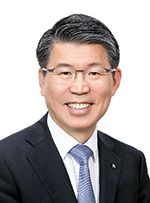Export-Import Bank of Korea Chairman and President Sung-soo Eun said the export credit agency’s latest Samurai issue was not just for its own funding needs but to pave the way for other Korean issuers to follow, stressing the double role Kexim has as the nation’s leading international borrower.
On June 21, the agency raised an impressive ¥120bn (US$1.08bn) split between ¥70bn 18-month notes and ¥50bn three-year bonds, making the most of the positive momentum after the historic June 12 summit between US President Donald Trump and North Korean leader Kim Jong Un.
“This deal was a great success and definitely contributed to Kexim’s own annual funding needs, as well as diversifying our funding horizon,” Eun told IFR during a trip to Tokyo for the signing ceremony.
The trade, via joint lead managers Daiwa, Merrill Lynch Japan Securities, Mitsubishi UFJ Morgan Stanley and Mizuho, was the largest Samurai issue from Asia ex-Australia.
Eun, who took office in September 2017, stressed that the success of the deal made clear that there is strong appetite among Japanese investors for Korean credits.
“I think there would be more issuance to follow,” he said. “I believe that is one of Kexim’s roles as a leading borrower – we are the first to test the market, do a successful deal, and pave the way for other issuers to follow.”
Indeed, Korean telecom service provider KT Corp returned to the Samurai market the following week with a ¥20bn dual-tranche two and three-year transaction.
Last month’s Kexim deal came after an almost three-year absence. The previous deal was done in September 2015 when it issued ¥16bn of two-year notes and ¥39bn of three-year bonds.
Explaining the long hiatus, Eun said: “Due to the cross-currency swap levels, it didn’t make much sense for us to raise funds in the Samurai market and swap them to use in another currency.”
He emphasised, however, that the Samurai market had always been at the top of the list for consideration, and said the agency’s commitment had shown its commitment to Japanese investors by holding numerous non-deal roadshows to Tokyo, including during its three-year absence from the primary market, to provide updates on its credit and performance.
Those efforts paid off on the agency’s return. Strong demand not just from Japanese but from foreign investors allowed Kexim to upsize the deal by ¥40bn from the originally planned ¥80bn. Its Double A rating also helped to bring in demand.
Kexim acknowledges that it paid a small premium in the three-year tranche over its US dollar secondary curve, but considers the cost worth paying if it meets its goal of diversifying its funding profile.
“Our top priority is achieving optimal funding cost,” Eun said. “But we also have to consider diversification of funding sources in order to secure stable funding, and diversification sometimes requires a slight premium.”
GEOPOLITICAL RISK
Kexim picked this time for the comeback for two reasons. “First, we have seen growth in our Japanese yen assets in recent months, which prompted a natural need for yen funding,” Eun said.
The second reason was the dramatic improvement in the geopolitical situation in and around the Korean peninsula. “[This] had been one of the key downside risks that many investors were voicing concerns over,” he said.
Several summits between the two Koreas culminated in the historic meeting between the US and North Korea in Singapore. “We felt the timing was ripe for us to return to the market,” Eun said. Less than a week later, Kexim started marketing the Samurai trade on June 18.
Kexim said it wants to stay committed to Japanese investors, who have traditionally been supportive of it and other Korean issuers.
“Japan is one of Korea’s closest neighbours with one of the largest credit markets in the world,” Eun said. “We want to stay committed to our investors and, once again, become a regular issuer in the Samurai market.”
Kexim sees the Samurai market as “crucial” to diversify its huge funding volume.
“Each year we raise around US$10bn-equivalent, but this amount cannot be raised solely from the dollar market, so we need to tap various non-US dollar markets,” Eun said. “Japanese investors sometimes become quite conservative, but, as our closest neighbour, they know us well, and this is one of the few markets where we can achieve a sizable issuance amount.”
Asked about its funding plan for the remainder of the year, Kexim gave no specific issuance schedule. “Our funding requirement for this year is US$8bn and we have already secured US$5.8bn, which is around 73% of our target, so we are quite comfortable with where we are at the moment,” he said.
Also holding Kexim back from issuing bonds is the possibility of market conditions becoming less favourable if US rates turn more volatile and a trade war between the US and China intensifies.
“We are seeing volatility pick up in the market and we see potential headwinds coming from a variety of sources as we move into the second half,” Eun said. “I believe now is the time to stay vigilant and remain flexible to adapt to this fast-changing environment.”
